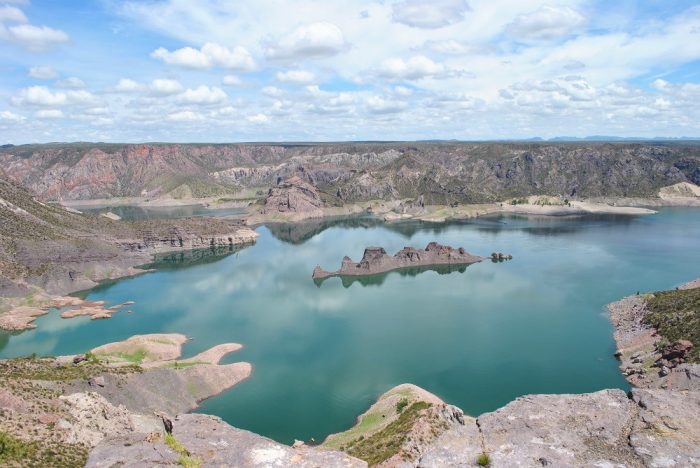The South zone of Mendoza is an excellent option to visit and to know. The access is easy since all its roads are largely asphalted, except for the route between Valle Grande and El Nihuil (by the Atuel Canyon), and they are safe if the necessary precautions are taken for the handling in mountain terrains. In addition there are service stations for fuel supply in the City of San Rafael and at the exit of El Nihuil. It is a one hundred and sixty-five kilometer touristic circuit that demands all day and is operable all year round.
Its route begins from the City of San Rafael, by National Route 143, Ballofet Avenue, six kilometers from the city passing by two iron bridges, take the curve to the left, and enter the first street on the right ( Cubillos – Provincial Route 173), who leads us to the area of Valle Grande, gateway to the majestic Atuel Canyon.
Upstream of this service center, there is the Valle Grande reservoir, one of the most important in the province, whose singular beauty is enhanced by walls of two hundred and fifty meters from the edge to the water mirror, site in which the Canyon is wider and deeper.
The wall of the Dique Valle Grande dam is 42 km from Villa El Nihuil. Its objective is to compensate the discharges of the power plants that make up the system. Its surface is 508 Ha. It is a lightened structure closure, type Noetzli-Alcorta, concrete, has a length of 300 m and a maximum height of 115 m.
The average annual temperature varies between 8.1 ° C and 23.1 ° C; Annual precipitation level of 343 millimeters. The annual distribution regime is summer, since from September to February the highest seasonal rainfall contributions are registered. Its thermal values, the intensity of sunlight, its reduced cloudiness, its moderate winds and low strength during much of the year, and the low percentage of relative humidity, are factors that contribute appropriately, so that its immense Emerald green water, be a temptation to carry out nautical activities such as: sailing, water skiing, windsurfing, diving, kayaking.
At only 10 km. and in contrast to this great body of water, the dunes that reach up to 200 m. of height and extend over an arid area of 30,000 ha. Stage of the Dakar on several occasions, the constant alteration of the relief makes it possible to live a unique experience with the company of a specialized guide.
Going through the Canyon of the Atuel, you can see the majestic walls in reddish, yellowish, ocher and grayish tones, represented in the “Wax Museum”, where tourists will free their imagination to discover innumerable forms of animals or human faces. Other curious formations that can be mentioned are: “The coniferous forest”, “The Monks”, “The Lizard”, “The Owl”, “The throne of the Inca”, “The elephants”, among others.
Bordering the Atuel Canyon, there is the river of the same name, that although it is born in Lake Atuel, it crosses various geographical environments along its 790 km, being part of important works of hydraulic potential (El Nihuil and Valle Grande). In this section of its route the flow of its water has a vertiginous fall of 35 m3 per second, ideal for the development of various tourist activities. At the edge of the Atuel River, the tourist infrastructure is abundant since it has all the services that the tourist needs, from camping, cabins, hotel, restaurants, grocery stores, sports facilities complemented by a forestation agreement. Also adventure tourism services, which are developed in the place, such as: river descent, kayaking, canoeing, horseback riding, rappel, climbing, zip line, hiking, paragliding, catamaran ride on the lake, mountain biking, rafting.
In the interior of the Atuel Canyon, we find the hydroelectric complex called Los Nihuiles, which with its three hydroelectric plants “Nihuil I, II and III, plus the two small artificial dams and lakes” Aisol “and” Tierras Blancas “, contribute to enhance Her beauty.
Emerging from the Atuel Canyon, through a winding slope, you reach the Villa del Nihuil. In this site is the largest reservoir in Mendoza, a huge lake that makes up the Nihuil dam of 9600 hectares, and in which a variety of fish species come to life that invites fishermen to give their favorite sport a free rein as they On the left margin is the Fishermen’s Club of San Rafael that provides all the necessary services.
In addition to fishing, the dike allows windsurfers to display their multicolored sails or those who practice water skiing, gliding swiftly over the serene waters. We also practice canoeing, sailing, yacht, nautical motorcycle, diving, swimming and adventure activities. This dike is the headquarters of the Pentatuel, an important sporting event of five disciplines that takes place every year in February.
As for its tourist infrastructure, the Villa offers services of cabins, hosteria, restaurant, there are campsites, boat rentals and other services. Also sports clubs that facilitate the performance of traditional sports and adventure tourism.
The return, to complete this circuit, is made from El Nihuil by Provincial Route 180 to intercept the National Route 144, descending the Cuesta de los Terneros, from the Sierra Pintada to San Rafael, and the last section, National Route 143 (Avenida Ballofet).






